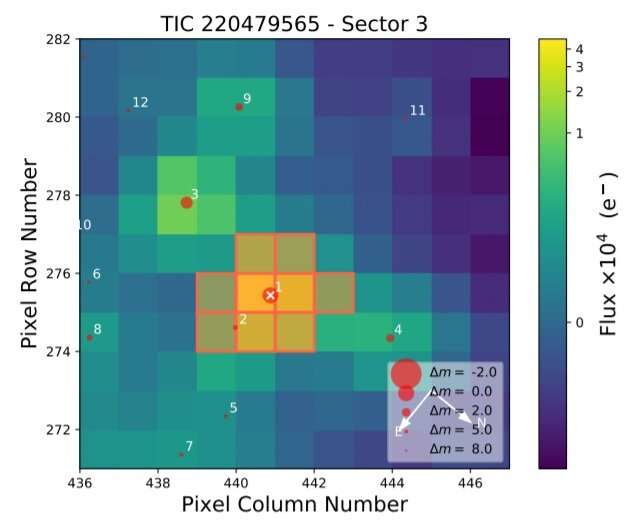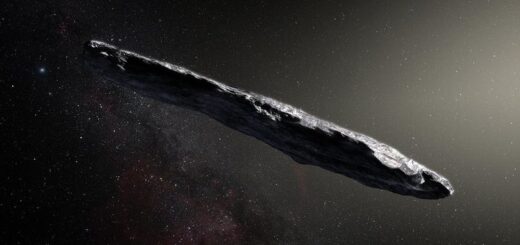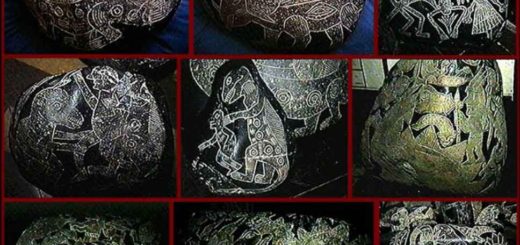New sub-Neptune exoplanet discovered by astronomers

A team of astronomers from the Grenoble Alpes University in France and elsewhere, reports the detection of a new sub-Neptune exoplanet orbiting an M dwarf star. The newly found alien world, designated TOI-269 b, is nearly three times larger than the Earth. The finding was detailed in a paper published April 30 on the arXiv pre-print repository.
NASA’s Transiting Exoplanet Survey Satellite (TESS) is conducting a survey of about 200,000 of the brightest stars near the sun with the aim of searching for transiting exoplanets. So far, it has identified nearly 2,700 candidate exoplanets (TESS Objects of Interest, or TOI), of which 125 have been confirmed so far.
TOI-269 (also known as TIC 220479565) is an M dwarf located some 186 light years away from the Earth. It has a spectral type of M2V, radius of about 0.4 solar radii and mass of approximately 0.39 solar masses. The star’s effective temperature is estimated to be some 3,500 K, while its metallicity is at a level of around -0.29.
TOI-269 was observed by the TESS spacecraft between September 2018 and July 2019, which resulted in the identification of a transit signal in its light curve. Now, using various ground-based telescopes, including the Exoplanets in Transits and their Atmospheres (ExTrA) facility at La Silla Observatory in Chile, a group of astronomers led by Marion Cointepas has confirmed the planetary nature of this signal.
“We present the confirmation of a new sub-Neptune close to the transition between super-Earths and sub-Neptunes transiting the M2 dwarf TOI-269,” the researchers wrote in the paper.
The newly detected alien world has a radius of about 2.77 Earth radii, is 8.8 times more massive than our planet and orbits its host every 3.7 days. The observations show that TOI-269 b is separated by around 0.0345 AU from the parent star and its equilibrium temperature is most likely at a level of 530 K.
What is interesting is that TOI-269 b has an unusually high orbital eccentricity—approximately 0.425. This is one of the highest eccentricities among the known extrasolar planets with periods below 10 days and suggests that the object may have recently arrived in its position.
“We surmise TOI-269 b may have acquired its high eccentricity as it migrated inward through planet-planet interactions,” the astronomers wrote in the study.
Moreover, the density of TOI-269 b, calculated to be some 2.28 g/cm3, is significantly lower than the typical density of rock planets and indicates the presence of a volatile envelope. Such low density and its other properties make it an interesting target for atmospheric characterization in order to compare it with other sub-Neptunes. In particular, the authors of the paper propose to probe the atmosphere of TOI-269 b with transmission spectroscopy to shed more light on its composition.



 Creators of mankind
Creators of mankind Description of “Tall white aliens”
Description of “Tall white aliens” Where they came from?
Where they came from? About hostile civilizations
About hostile civilizations The war for the Earth
The war for the Earth “Tall white aliens” about eternal life
“Tall white aliens” about eternal life Video: “Nordic aliens”
Video: “Nordic aliens” Aliens
Aliens Alien encounters
Alien encounters The aliens base
The aliens base UFO
UFO Technology UFO
Technology UFO Underground civilization
Underground civilization Ancient alien artifacts
Ancient alien artifacts Military and UFO
Military and UFO Mysteries and hypotheses
Mysteries and hypotheses Scientific facts
Scientific facts


















